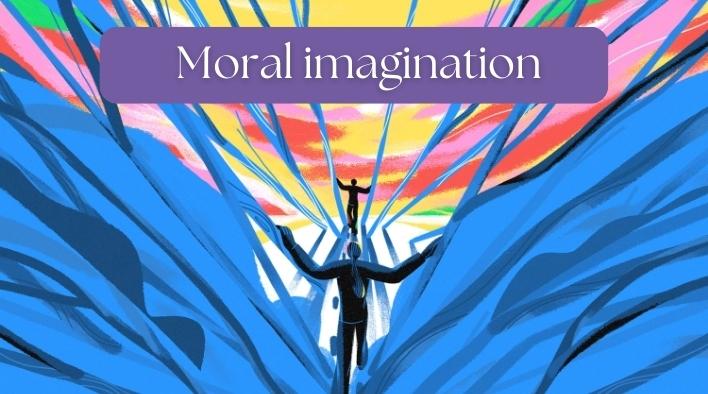Moral imagination
William House, Retired GP; JHH editorial board member
Published in JHH17.3 – Beyond Covid
The overall theme of this issue of the Journal is reimagining healthcare. ‘Reimagining’ excites me and draws me in, wanting more. I turned to a fascinating 1997
article by P Anne Scott Imagination in practice (Scott, 1997). I was struck by her use of unfamiliar words. She makes it clear in the text that these words communicate aspects of healing relationships which are recognisable, potentially very important, but for which we lack adequate familiar language. She is right. A key example is ‘moral imagination’. Here is an extract from her article including her simple explanation of moral imagination (italic section). This works for me.
…one cannot sympathise or empathise with a patient if one cannot imaginatively enter into the world of the particular patient with whom one is in contact. The problem would thus seem to be one of lack of imagination. Nurses (and other health care practitioners) can reasonably be expected to have the imaginative sensitivities which would allow and/or encourage feelings and attitudes of sympathy and empathy between the practitioner and the patient.
Scott goes on to suggest that it is the ‘fine-tuning’ of the imagination that is missing in many practitioners. By this she means: ‘…that aspect of the imagination which allows the practitioner … to believe that here exists a human being: a person such as I’. This is the aspect of the imagination which, in Henry James’ words, allows one to be ‘finely aware and richly responsible’ (James, 1907). Scott’s key message is that practitioners must:
…clearly understand the possible or likely implications of their decisions from within the psychosocial context of the patient, rather than simply consider the medical implications … I suggest that this engagement comes only through activity of the moral imagination.
In Scott’s article, the application of moral imagination is seen as a form of intellectual virtue akin to Aristotelian phronesis (often translated as ‘practical wisdom). This is difficult to achieve without …
…sufficient context, sufficient story, for the practitioner to begin imaginatively to identify with the particular patient.
Failure to achieve this human connection is potentially damaging to both patient and physician. In terms of the physician: ‘One may stagnate behind a self protective wall or one may be forced to channel one’s energies into strengthening the wall, resulting in a shrinking of one’s own humanity’. On a wider scale, ‘… burnout, attrition from the professions and poor patient care are almost inevitable scenarios’ (Scott, 1997).
Scott’s suggested remedy is the development of the physician’s own moral imagination.
If the practitioner can imaginatively identify with a particular patient during certain trying situations, the focus of the practitioner’s attention is on the patient
rather than on himself or herself … the practitioner’s practice becomes patient-centred …. resulting in an enriching and an enlarging of the perspective of the practitioner.’ Later Scott includes a quotation from the American philosopher and professor of law and ethics in Chicago, Martha Nussbaum, concerning the moral imagination in the context of lack of compassion and even of care in healthcare:
The claim seems to be that if you really vividly experience a concrete human life, imagine what it’s like to live that life, and at the same time permit yourself the full range of emotional responses to that concrete life, you will (if you have at all a good moral start) be unable to do certain things to that
person. Vividness leads to tenderness, imagination to compassion.
The question for the physician is how to go about achieving this ‘vividness’, how to find our moral imagination and enhance our tenderness and compassion? The answer to this may come from a seemingly unlikely source. There is increasing evidence that reading particular kinds of novels and other literary sources may enable such a transformation (Gillon, 1997; Mcardle and Byrt, 2003).
My own experience of training in medicine in the UK and ultimately working as a GP in south west England for around 30 years, reinforces the association of medical practice with the arts.
In short, the science of medicine must, if it is to optimise achievement of its objective of improving the practice of healthcare, collaborate with the art of medicine, a central part of which is the understanding of people, especially sick people.’ (Gillon, 1997)
References
- Gillon R (1997) Imagination, literature, medical ethics and medical practice. Journal of Medical Ethics, 23, 3–4.
- James H (1907) The art of the novel. Charles Scribner and Sons.
- Mcardle S, Byrt R (2003) Fiction, poetry and mental health: expressive and therapeutic uses of literature. Journal of Psychiatric and Mental Health
Nursing 8(6). - Scott P A (1997) Imagination in practice. Journal of Medical Ethics, 23, 45–50.







